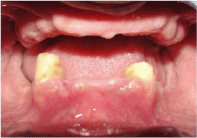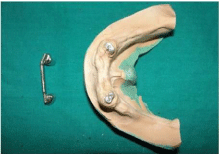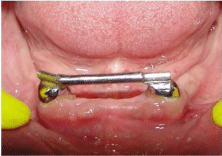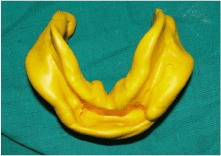
Case Report
J Dent & Oral Disord. 2017; 3(2): 1056.
Fabrication of a Mandibular Bar Supported Overdenture Using Preci-Vertex System
Jurel SK, Singh SV*, Aggarwal H, Chand P, Singh RD and Arya D
Department of Prosthodontics, Faculty of Dental Sciences, King George’s Medical University UP, India
*Corresponding author: Saumyendra V. Singh, Department of Prosthodontics, Faculty of Dental Sciences, King George’s Medical University UP, India
Received: February 16, 2017; Accepted: April 11, 2017; Published: April 18, 2017
Abstract
Preventive prosthodontics emphasizes the importance of any procedure that can delay or eliminate future prosthodontic problems. In the past, when patients presented themselves as candidates for a denture with teeth that were badly broken down with periodontal involvement or without the ability to financially support extensive restorative treatment, such teeth were extracted. Retention of one or more teeth for an overdenture offers the patient a lot of advantages like better stability, proprioception and support among a few. The following report is of such a case, where solely retained mandibular canines were not extracted and were used to support a mandibular bar retained overdenture.
Key Message: Techniques for retention of endodontically treated and filled roots as abutments beneath overdentures have been an important treatment modality to delay bone loss. This case report is an effort to describe how these overdenture abutments can be utilized for support under a complete denture. Clinical indications and technical considerations have been described along with advantages and potential complications.
Keywords: Bar supported overdenture; Preventive prosthodontics; Coping; Attachments
Introduction
The basic principle in prosthodontics is to retain whatever is remaining as stated by De-van. The inferior functional status of conventional complete dentures is because of their dependence on mucoperiosteal foundation for support and stability, which itself undergoes constant changes. Presently, the field of implantology has seen considerable development to overcome such problems. But at the same time, it is costly and time consuming requiring surgical intervention. In such a situation, tooth supported overdenture is a viable alternative.
The overdenture treatment derives supplementary support and retention from teeth retained under denture base after these teeth have been intentionally reduced to a gingival level. This enhances denture performance as overlaid roots not only transmit more detailed information through the sensory nuclei to the motor centres and muscles [1,2] but also increase chewing power during mastication [3,4]. Overdentures also have a longer life expectancy since root presence renders the foundation less susceptible to timeand stress-related resorption. Moreover, recent advances in precision attachments for overdentures have made overdenture treatment, a considerable clinical success [5].
The bar clip attachment is an excellent method of increasing the retention and stability of an overdenture [6]. It also provides splinting of abutments. But sometimes, non-parallelism of abutment may complicate its design and it requires greater interocclusal space [7]. This case report describes fabrication of bar attachment using a preci-vertix [8] attachment system originally used as an extracoronal attachment in removable partial dentures. The system consists of a prefabricated bar (male part) and clip (female part) attachment.
The clips are made of nylon which is a bit flexible and it gets locked with the bar, which provides excellent retention and stability to the prosthesis.
Case Presentation
A 53-year-old male patient reported to the outpatient department of Prosthodontics with the chief complaint of difficulty in chewing due to missing teeth and desire to improve esthetics. On intraoral examination teeth present were, 33, and 43. The teeth were firm with severe attrition .The upper and lower edentulous span had favorable ridge with firmly attached keratinized mucosa. No significant systemic extra oral or intraoral anomaly was detected. The maxillary and mandibular ridges were well formed, the palatal vault and soft palate were favorably shaped and no pre-prosthetic surgery was required. As the patient was unwilling to undergo surgical intervention and as mandibular canines appeared favorable according to clinical and radiological examination, it was decided to treat the patient with a maxillary complete denture and a mandibular complete overdenture. Further determination of the Vertical Dimension of Occlusion (VDO) was achieved using phonetics, swallowing, patient preference and facial appearance. It was determined that the interocclusal gap was approximately 8 mm (Figure 1).

Figure 1: Preoperative view showing inter arch space.
This space was insufficient to accommodate the canines in their entirety and therefore they had to be endodontically treated in a single visit appointment. These were prepared to form a finish line of 1.5mm and the abutments shaped like a dome of 2 mm height (Figure 2). Following abutment preparation, impression was made with polyvinyl siloxane (Express XT Penta H and Express XT Light Body Standard, 3M ESPE, Division St. Paul, MN) and poured in die stone material. A wax pattern of the coping with the plastic pattern of the pre-fabricated preci-vertix attachment attached to it was fabricated. This pattern was cast, finished and polished (Figure 3).

Figure 2: Endodontically treated abutment teeth prepared to receive copings.

Figure 3: Cast and finished mandibular bar supported overdenture.
The bar attachment was checked for fit and was luted on the abutments using glass ionomer luting cement (GC Fuji I, GC Corporation, Japan) (Figure 4). The under surface of bar was blocked using modelling wax before taking preliminary impression using irreversible hydrocolloid material (Zelgan 2002; Dentsply-India, Gurgaon, India), so as to prevent material from locking below the bar. A special tray was fabricated using auto-polymerizing resin (DPI, Mumbai) and final impression was made using polyvinyl siloxane material (Express™ XT Penta™ H, 3MESPE, Division St. Paul, MN) (Figure 5) Jaw relations, try-in, processing and finishing of dentures were performed in usual manner.

Figure 4: Mandibular bar supported over denture luted intra- orally.

Figure 5: Final impression of luted mandibular bar supported overdenture.
The mandibular denture with space for the bar to be contained within it was thus fabricated (Figure 6). The preci-vertex attachment contains 2 parts: a male part, which is retained in patient’s mouth and a female nylon part, which is retained in prosthesis. Now, to retain the female part in the denture, nylon female part was fitted to the male part in patient’s mouth and auto-polymerizing resin (DPI, Mumbai) was added to the corresponding space in the denture and dentures were seated into position. This was done after again blocking the space between the bar and the ridge. As the self- cure resin polymerised, the dentures were removed and inspected for any deficiencies (Figure 7). Dentures were inserted and patient was called for post-insertion adjustments after 2 days.

Figure 6: Maxillary complete denture and mandibular bar supported over
denture before attachments of nylon clips.

Figure 7: Mandibular bar supported overdenture with female part in form of
nylon sleeves.
Discussion
Overdenture therapy constitutes essentially a preventive prosthodontic concept as it endeavors to preserve the few remaining teeth and the supporting structures [8-11]. The teeth which are too weak to support a fixed partial denture and are considered unsuitable to support a removable partial denture can oftentimes be usefully conserved and suitably modified to act as abutments under over dentures for useful span of time. The over denture theory and practice is based on rational principles and the procedures involved have been standardized and simplified to such an extent that this modality of treatment should be considered for virtually every patient for whom full mouth extractions were planned.
Retention is key in removable prosthodontics and there is strong evidence that it is of great importance in patient satisfaction. Burns et al used a cross over design to find strong patient preference for overdenture attachments with better retention [12]. Lesser retention and resistance of mandibular dentures can cause reduced stability and decreased masticatory performance in turn [13]. Though proper extension, adhesion, neuromuscular function are important in mandibular overdenture retention, attachments play a key roleprominent among which are bars, studs and magnets. Controversy exists as to which type of attachment is preferable and requires less post insertion servicing [14].
It is a documented fact that after the loss of the teeth the residual alveolar ridge undergoes rapid loss in all dimensions. The phenomenon of Residual Resorption (RRR) following removal of teeth been well observed and documented in literature [15,16]. While the bone loss following the removal of teeth is stated to be rapid, progressive, irreversible and inevitable, it is equally well observed that bone is maintained around standing teeth and implants. The residual ridge is faster and more marked in lower arch [16,17]. It is thus imperative that we endeavor to maintain a suitable complement of so called ‘terminal dentition’ in order to preserve the alveolar bone. The rational measures to preserve such retained teeth concentrate on improving their periodontal status which includes reducing mobility, improving crown: root ratio and minimizing leverage and horizontal stress concentration. However, it cannot be over emphasized that good principles of complete denture construction must be followed in letter and spirit to achieve optimum results from the overdenture therapy.
Conclusion
The preci-vertex mandibular bar supported overdenture provided good retention for the prosthesis, along with all other advantages of an overdenture. A long term limitation may be that the nylon clips wear down and have to be replaced from time to time. Adding a bar would only be possible in patients with adequate IOG, though it circumvents the problems which may arise from individual overdenture attachments in non parallel planes.
References
- Sposetti VJ, Gibbs CH, Alderson TH, Jaggers JH, Richmond A, Conlon M, et al. Bite force and muscle activity in overdenture wearers before and after attachment placement. J Prosthet Dent. 1986; 55: 265-273.
- Mushimoto E. The role in maaseter muscle activities of functionally elicited periodontal afferenta from abutment teeth under overdentures. J Oral Rehabil. 1981; 44: 441-455.
- Rissin L, House JE, Manly RS, Kapur KK. Clinical comparison of masticatory performance and electromygraphic activity of patients with complete dentures, overdentures, and natural teeth. J Prosthet Dent. 1978; 39: 508-511.
- Nagasava T, Okane H, Tsuru H. The role of the periodontal ligament in overdenture treatment. J Prosthet Dent. 1979; 42: 6-12.
- Preiskel HW, Arvidson K, Geering AH, Mericske-Stern R. Overdentures made easy, a guide to implant and root supported prostheses. Chicago: Quintessance Publishing; 1996.
- Dolder EJ. The bar joint mandibular denture. J Prosthet Dent. 1961; 11: 689-707.
- Marquardt GL. Dolder bar joint mandibular overdenture: a technique for nonparallel abutment teeth. J Prosthet Dent. 1976; 36: 101-111.
- Henking JP. Overdentures. J Dent. 1982; 10: 217.
- Reitz PV, Weiner MG, Levin B. An Overdenture survey: Preliminary report. J Prosthet Dent. 1977; 37: 246-258.
- Ausburger RH. The Gilmore attachment. J Prosthet Dent. 1966: 16: 1090.
- Miller PA. Complete denture supported by natural teeth. J Prosthet Dent. 1958; 8: 924.
- Burns DR, Unger JW, Elswick RK, Giglio JA. Prospective clinical evaluation of mandibular implant overdentures: Part II- Patient satisfaction and preference. J Prosthet Dent. 1995; 73: 364-369.
- Fontjin –Tekamp FA, Slagter AP, Van Der Bitt A, Van THMA, Witter DJ, Kalk W, et al. Biting and chewing in overdentures, full dentures and natural dentitions. J Dent Res. 2000; 79: 1519-1524.
- Mericske- Stern R. Three dimensional force measurements with mandibular overdentures connected to implants by ball shaped retentive anchors: A clinical study. Int J Oral Maxillofac Implants. 1998; 13: 36-43.
- Toolson LB, Smith DE. A two year longitudinal study of overdenture patients, Part 1:incidence and control of caries on overdenture abutments. J Prosthet Dent. 1978; 40: 486.
- Tallgreen A. Positional changes of complete dentures- a seven year longitudinal study. Acta Odontol. Scand. 1969; 27: 539.
- Tallgreen A. The continuing reduction of residual alveolar ridges in complete denture wearers: a mixed longitudinal study covering 25 years. J Prosthet Dent. 1972; 27: 120-132.